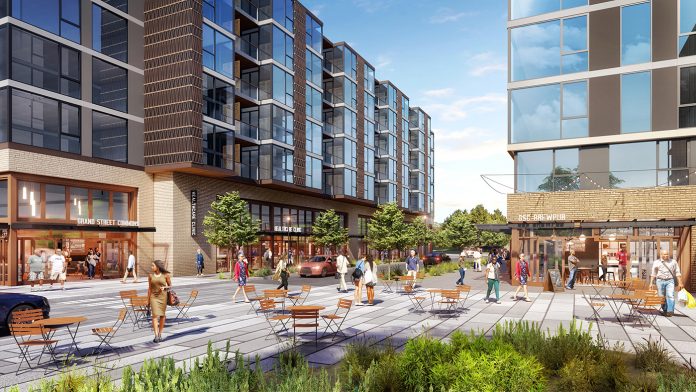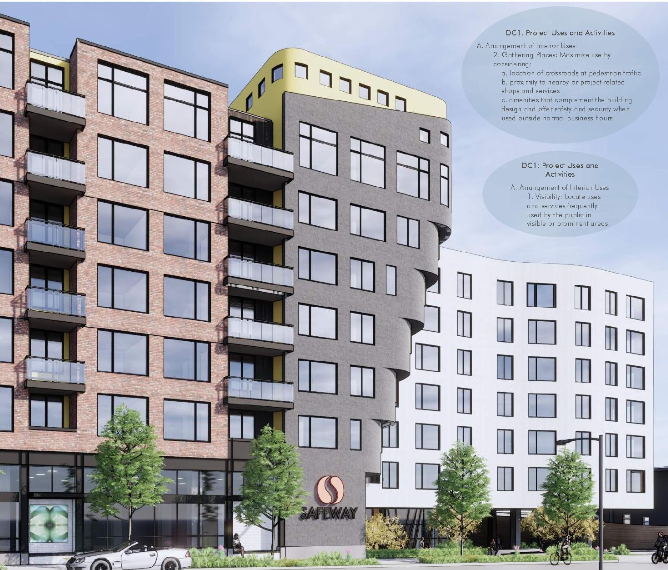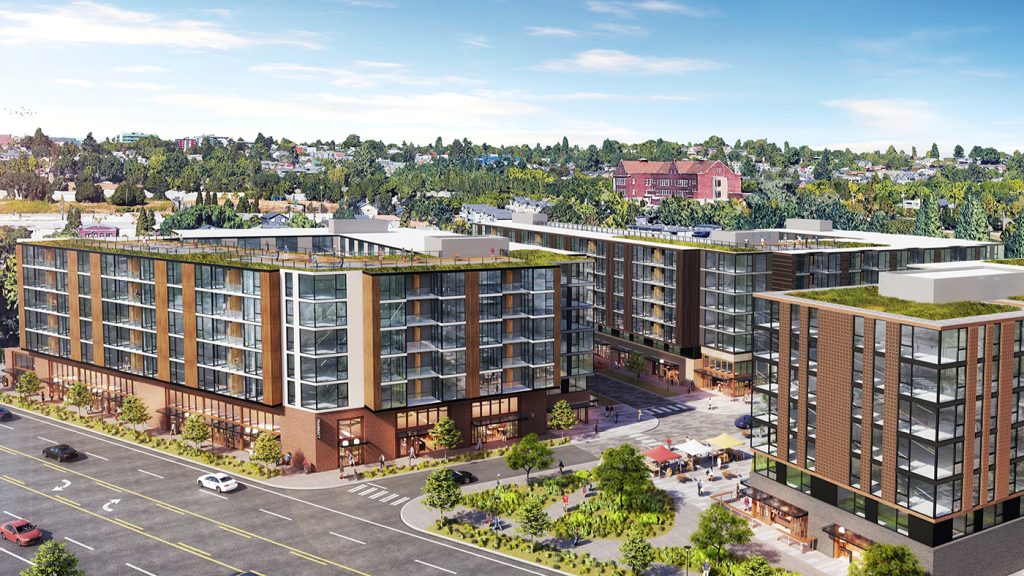
Last week, the Seattle City Council couldn’t muster the votes to pass an emergency ordinance to keep design review moving during the pandemic era, coming up a vote shy. Yesterday that vote flipped and it passed. Councilmember Tammy Morales provided the decisive seventh vote needed to pass the emergency ordinance–as Councilmembers Alex Pedersen and Lisa Herbold continued to hold out against the measure.
The emergency ordinance will alleviate a logjam caused by the cancellation of design review meetings over the past two months. In the short-term, those projects will move into administrative design review carried out by staff at the Seattle Department of Construction and Inspections (SDCI). In the medium-term, design approval will revert to the volunteer design review boards once a system is set up for holding online meetings and taking public input remotely. That must happen within six months or else the special administrative path will disappear.
The exception is affordable housing projects, which will remain under SDCI’s purview and on an expedited track. Supporters pointed how the COVID-19 triggered recession makes the need for affordable housing more dire and delaying delivery of that housing would worsen the suffering from the recession.
Councilmembers unanimously passed a Morales amendment that treated differently the International Special Review District (ISRD) in the Chinatown-International District–where Morales said planned projects are overwhelmingly hotels and market-rate condos rather than affordable housing. Under revised language, the ISRD can meet electronically, although approvals are postponed until robust public input can resume.
Though she supported the final bill with her amendment included, Councilmember Morales said she remained conflicted on the ordinance, reiterating her belief that it conflated issues of participation and affordable housing. She portrayed development as at odds with communities facing displacement pressure in her district, which stretches from the Chinatown to Rainier Beach
“I was elected to stop displacement,” Morales said. “Making the development process easier is rarely a benefit to the communities I represent. The trade-off is that what is seen as efficient for government or for developers often means inequity in my community.”
Morales added her vote would be the “first and last concession in the name of easing process or relieving administrative burdens, especially if it means accelerating disaster gentrification.” Slowing down the process can ensure her community is heard, she argued, but “don’t mistake that for naivete or confusion. It’s about ensuring those voices have access to power.”
Councilmember Andrew Lewis’s vote also seemed to come with some reservations after he offered a last-minute amendment to block projects participating in the Living Building pilot program from availing themselves of administrative design review.
“The buildings that going forward under the pilot program are of a particular size and bulk that design review is more important than for similarly situated projects that are not part of the Living Building pilot program,” Lewis said. “Given the status of the three projects this would address, all of which are midstream through the established in-person design review process, that it would be warranted for these projects to continue on in that path and go back to the design review boards, be they in person or virtual, to get the final go ahead to proceed to the Master Use Permit.”
Lewis’s verbal gymnastics may sound innocuous enough, but still the intent was to hold up projects seeking to meet the City’s highest standard for environmental sustainability. In particular, Lewis seemed to be channeling a group of his constituents who’ve been seeking to block a proposal to build a seven-story Living Building proposal at the site of the Magnolia Albertsons, which will soon be converted to a Safeway.

Councilmember Dan Strauss, who chairs the land use committee and sponsored the emergency ordinance, alluded to as much in his comments as he complimented Lewis’s constituent outreach: “I just want all of Councilmember Lewis’s constituents to know he is doing work in their stead.”
Councilmember Teresa Mosqueda disagreed with Lewis’ premise that residents wouldn’t be able to make their voices heard without in-person design review meetings.
“All the same public engagement opportunities exist; they just take a different form,” Mosqueda said. “People can call [or] send written comments to SDCI rather than provide comments in person. The steps in the administrative design review process are publicly posted through SDCI’s website, and if you sign up… you receive notifications on all materials submitted.”
The existing design review process isn’t terribly inclusive and open to working class families, as Mosqueda pointed out.
“It’s arguably more inclusive to be able to accept phone calls and written comments than just having meetings in person,” Mosqeuda said. “Think of all the folks who are working two or three jobs, the people who would like to be there but for there responsibilities at home or at work or mobility issues, and we want to be sure we’re thinking about inclusivity and equity as we think about soliciting public comment, especially during COVID. I think this bill strikes that nice balance.”
Furthermore, Mosqueda said Living Buildings are exactly the kind of buildings the City should be encouraging rather than throwing up more obstacles.
“These are socially just, sustainable, human-health oriented green buildings,” Mosqueda said. “This is not just about setbacks or green roofs, it’s about incorporating nature in every aspect of the building design, the materials, and the energy systems to create spaces that integrate the physical and psychological well-being of people and the healthy of the surrounding environment. I think it’s really important that we think about about how we encourage more developers to go this route.”
Lewis’s amendment was rejected after garnering only three votes, with Councilmembers Pedersen and Herbold joining its author.
Magnolia, by the way, is 90% White and doesn’t have a designated Urban Village since the neighbors who participated in the 1994 neighborhood planning process balked at including one there. Grandfathered-in mixed-use buildings and zoning in Magnolia Village and along Gilman Avenue W (tracking along former streetcar routes) sort of fills the role of an Urban Village–albeit in a constricted fashion. The Urbanist has argued the City should establish Urban Villages in Magnolia and in other areas conspicuously excluded–which incidentally tend to be wealthier, whiter neighborhoods–to rectify past mistakes and more evenly and equitably spread growth across the city. And in the meantime, building super-green apartment buildings there sounds great, too. But I digress.
To watch the full discussion from yesterday’s City Council meeting, watch the Seattle Channel video.

Mayor Jenny Durkan backed the emergency ordinance and is expected to sign it, allowing it to come into immediate force.
The legislation also temporarily alters the process for historic structures. The ordinance allows the Department of Neighborhoods to administratively approve changes to historic structures or buildings in many historic districts, as well as assume the role of negotiating with owners for landmarking controls of a nominated structure prior to the next landmarks board meeting for designation.
The City Council also passed legislation proposed by Mayor Durkan to cap fees on app-based food delivery services at 15% and to guarantee 100% of tips go to employees. The bill was intended to prevent price gouging as consumers and small businesses become increasingly reliant on food delivery services.
The featured image if courtesy of Lake Union Partners and shows Grand Street Commons, a 700-home complex in North Rainier. The developer was hoping to break ground late this year or in 2021–at least before the pandemic hit.
Doug Trumm is publisher of The Urbanist. An Urbanist writer since 2015, he dreams of pedestrianizing streets, blanketing the city in bus lanes, and unleashing a mass timber building spree to end the affordable housing shortage and avert our coming climate catastrophe. He graduated from the Evans School of Public Policy and Governance at the University of Washington in 2019. He lives in East Fremont and loves to explore the city on his bike.


